Analyzing Risk Profiles: Rio Tinto vs. BHP Billiton
VerifiedAdded on 2020/05/28
|13
|2193
|141
AI Summary
The analysis compares the risk profiles of Rio Tinto and BHP Billiton by evaluating their strategic, operational, and governance risks alongside financial metrics like debt equity ratios and earnings per share. While both companies face significant risks in mining operations, Rio Tinto exhibits a higher risk profile compared to BHP Billiton, particularly concerning its debt management. Through various control measures including specialized teams and audit systems, each company attempts to mitigate these inherent risks. The study concludes that although Rio Tinto has implemented robust controls, it still holds a relatively higher financial risk than BHP Billiton as evidenced by their respective solvency ratios and earnings performance.
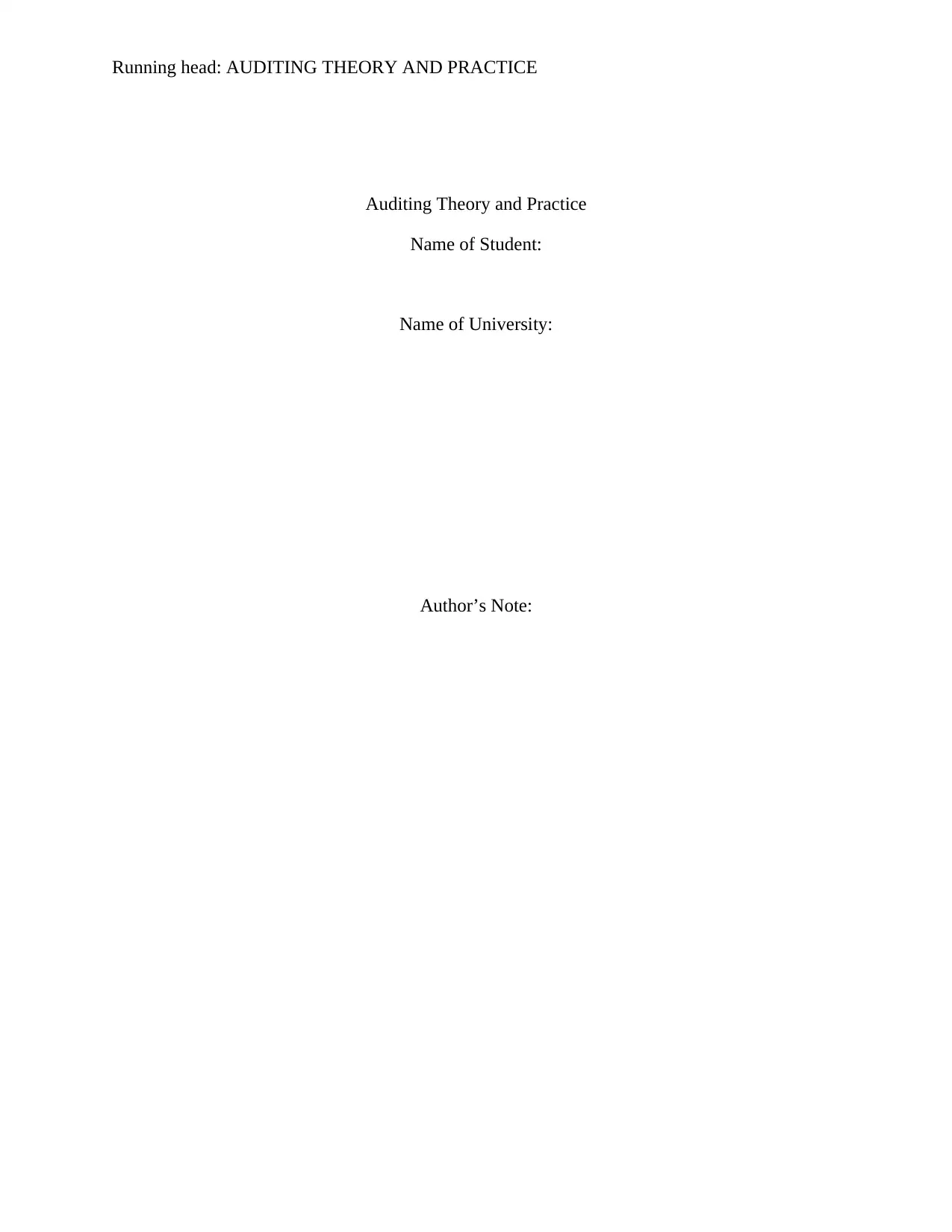
Running head: AUDITING THEORY AND PRACTICE
Auditing Theory and Practice
Name of Student:
Name of University:
Author’s Note:
Auditing Theory and Practice
Name of Student:
Name of University:
Author’s Note:
Paraphrase This Document
Need a fresh take? Get an instant paraphrase of this document with our AI Paraphraser
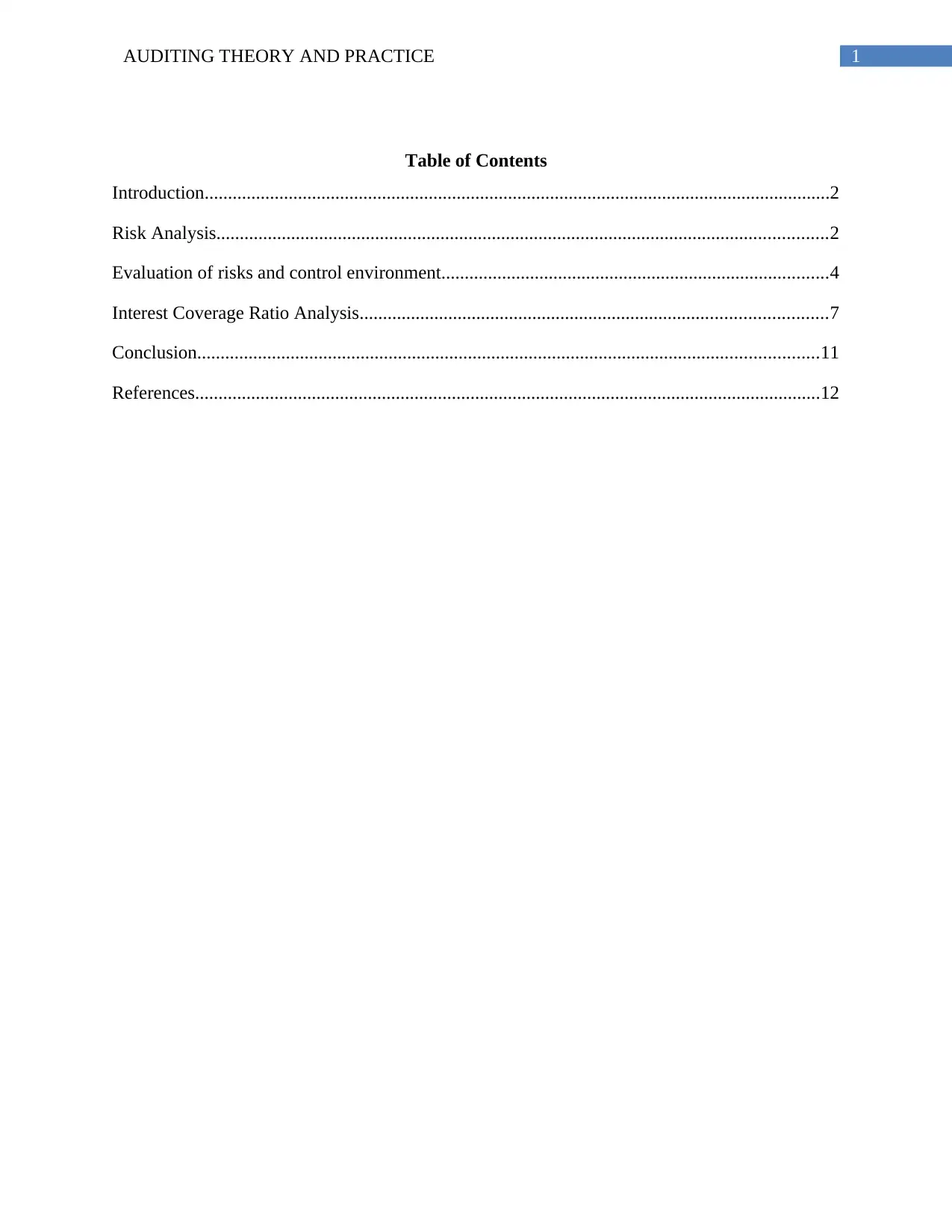
1AUDITING THEORY AND PRACTICE
Table of Contents
Introduction......................................................................................................................................2
Risk Analysis...................................................................................................................................2
Evaluation of risks and control environment...................................................................................4
Interest Coverage Ratio Analysis....................................................................................................7
Conclusion.....................................................................................................................................11
References......................................................................................................................................12
Table of Contents
Introduction......................................................................................................................................2
Risk Analysis...................................................................................................................................2
Evaluation of risks and control environment...................................................................................4
Interest Coverage Ratio Analysis....................................................................................................7
Conclusion.....................................................................................................................................11
References......................................................................................................................................12
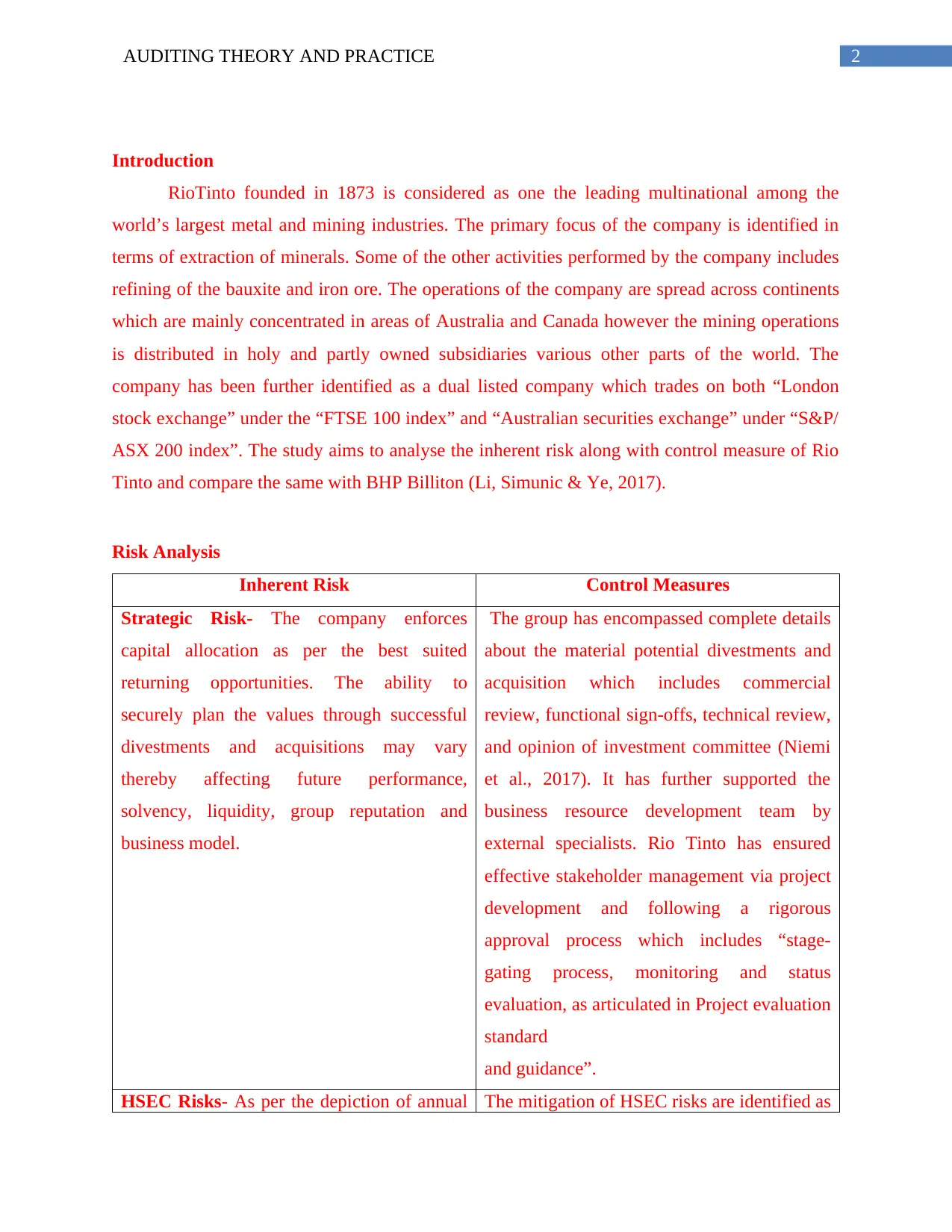
2AUDITING THEORY AND PRACTICE
Introduction
RioTinto founded in 1873 is considered as one the leading multinational among the
world’s largest metal and mining industries. The primary focus of the company is identified in
terms of extraction of minerals. Some of the other activities performed by the company includes
refining of the bauxite and iron ore. The operations of the company are spread across continents
which are mainly concentrated in areas of Australia and Canada however the mining operations
is distributed in holy and partly owned subsidiaries various other parts of the world. The
company has been further identified as a dual listed company which trades on both “London
stock exchange” under the “FTSE 100 index” and “Australian securities exchange” under “S&P/
ASX 200 index”. The study aims to analyse the inherent risk along with control measure of Rio
Tinto and compare the same with BHP Billiton (Li, Simunic & Ye, 2017).
Risk Analysis
Inherent Risk Control Measures
Strategic Risk- The company enforces
capital allocation as per the best suited
returning opportunities. The ability to
securely plan the values through successful
divestments and acquisitions may vary
thereby affecting future performance,
solvency, liquidity, group reputation and
business model.
The group has encompassed complete details
about the material potential divestments and
acquisition which includes commercial
review, functional sign-offs, technical review,
and opinion of investment committee (Niemi
et al., 2017). It has further supported the
business resource development team by
external specialists. Rio Tinto has ensured
effective stakeholder management via project
development and following a rigorous
approval process which includes “stage-
gating process, monitoring and status
evaluation, as articulated in Project evaluation
standard
and guidance”.
HSEC Risks- As per the depiction of annual The mitigation of HSEC risks are identified as
Introduction
RioTinto founded in 1873 is considered as one the leading multinational among the
world’s largest metal and mining industries. The primary focus of the company is identified in
terms of extraction of minerals. Some of the other activities performed by the company includes
refining of the bauxite and iron ore. The operations of the company are spread across continents
which are mainly concentrated in areas of Australia and Canada however the mining operations
is distributed in holy and partly owned subsidiaries various other parts of the world. The
company has been further identified as a dual listed company which trades on both “London
stock exchange” under the “FTSE 100 index” and “Australian securities exchange” under “S&P/
ASX 200 index”. The study aims to analyse the inherent risk along with control measure of Rio
Tinto and compare the same with BHP Billiton (Li, Simunic & Ye, 2017).
Risk Analysis
Inherent Risk Control Measures
Strategic Risk- The company enforces
capital allocation as per the best suited
returning opportunities. The ability to
securely plan the values through successful
divestments and acquisitions may vary
thereby affecting future performance,
solvency, liquidity, group reputation and
business model.
The group has encompassed complete details
about the material potential divestments and
acquisition which includes commercial
review, functional sign-offs, technical review,
and opinion of investment committee (Niemi
et al., 2017). It has further supported the
business resource development team by
external specialists. Rio Tinto has ensured
effective stakeholder management via project
development and following a rigorous
approval process which includes “stage-
gating process, monitoring and status
evaluation, as articulated in Project evaluation
standard
and guidance”.
HSEC Risks- As per the depiction of annual The mitigation of HSEC risks are identified as
⊘ This is a preview!⊘
Do you want full access?
Subscribe today to unlock all pages.

Trusted by 1+ million students worldwide
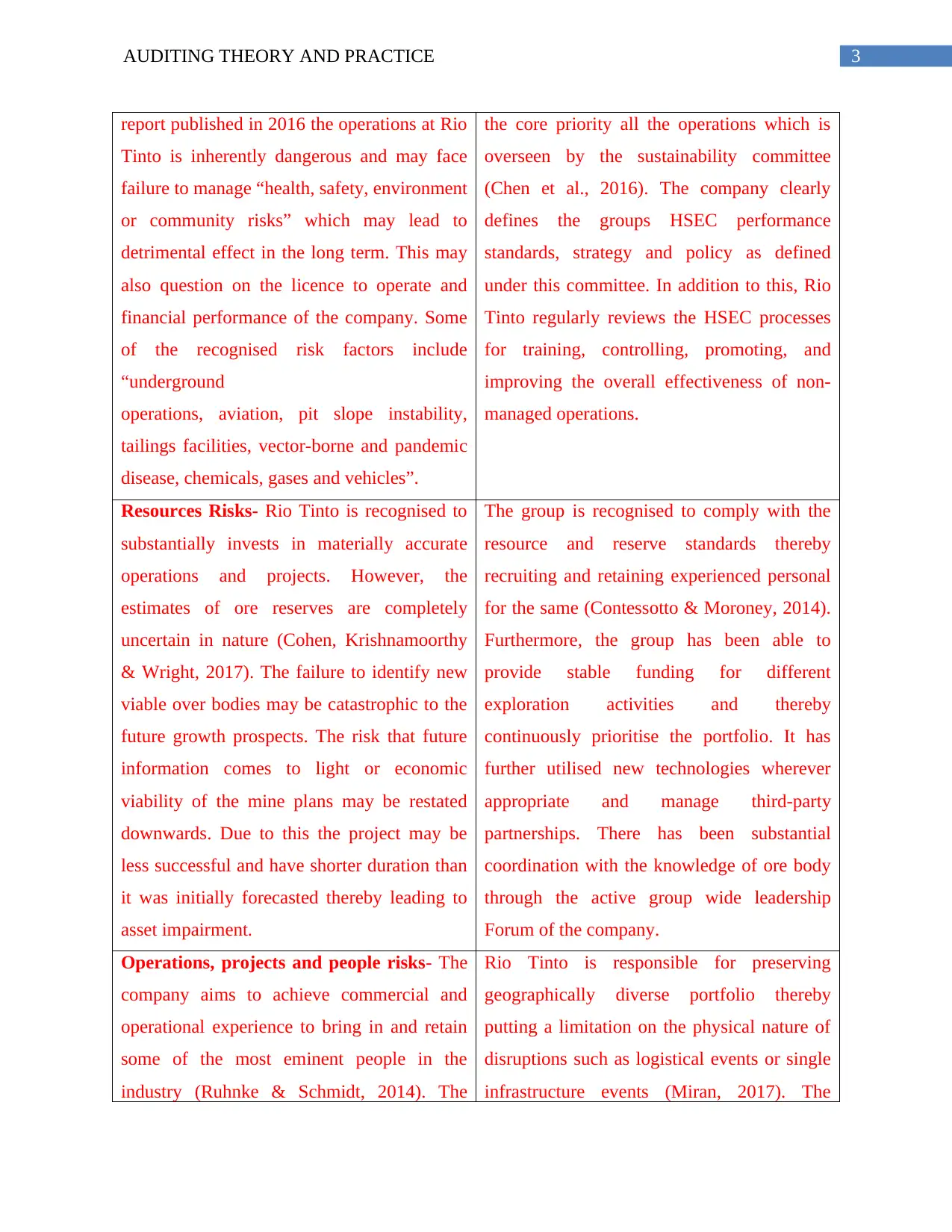
3AUDITING THEORY AND PRACTICE
report published in 2016 the operations at Rio
Tinto is inherently dangerous and may face
failure to manage “health, safety, environment
or community risks” which may lead to
detrimental effect in the long term. This may
also question on the licence to operate and
financial performance of the company. Some
of the recognised risk factors include
“underground
operations, aviation, pit slope instability,
tailings facilities, vector-borne and pandemic
disease, chemicals, gases and vehicles”.
the core priority all the operations which is
overseen by the sustainability committee
(Chen et al., 2016). The company clearly
defines the groups HSEC performance
standards, strategy and policy as defined
under this committee. In addition to this, Rio
Tinto regularly reviews the HSEC processes
for training, controlling, promoting, and
improving the overall effectiveness of non-
managed operations.
Resources Risks- Rio Tinto is recognised to
substantially invests in materially accurate
operations and projects. However, the
estimates of ore reserves are completely
uncertain in nature (Cohen, Krishnamoorthy
& Wright, 2017). The failure to identify new
viable over bodies may be catastrophic to the
future growth prospects. The risk that future
information comes to light or economic
viability of the mine plans may be restated
downwards. Due to this the project may be
less successful and have shorter duration than
it was initially forecasted thereby leading to
asset impairment.
The group is recognised to comply with the
resource and reserve standards thereby
recruiting and retaining experienced personal
for the same (Contessotto & Moroney, 2014).
Furthermore, the group has been able to
provide stable funding for different
exploration activities and thereby
continuously prioritise the portfolio. It has
further utilised new technologies wherever
appropriate and manage third-party
partnerships. There has been substantial
coordination with the knowledge of ore body
through the active group wide leadership
Forum of the company.
Operations, projects and people risks- The
company aims to achieve commercial and
operational experience to bring in and retain
some of the most eminent people in the
industry (Ruhnke & Schmidt, 2014). The
Rio Tinto is responsible for preserving
geographically diverse portfolio thereby
putting a limitation on the physical nature of
disruptions such as logistical events or single
infrastructure events (Miran, 2017). The
report published in 2016 the operations at Rio
Tinto is inherently dangerous and may face
failure to manage “health, safety, environment
or community risks” which may lead to
detrimental effect in the long term. This may
also question on the licence to operate and
financial performance of the company. Some
of the recognised risk factors include
“underground
operations, aviation, pit slope instability,
tailings facilities, vector-borne and pandemic
disease, chemicals, gases and vehicles”.
the core priority all the operations which is
overseen by the sustainability committee
(Chen et al., 2016). The company clearly
defines the groups HSEC performance
standards, strategy and policy as defined
under this committee. In addition to this, Rio
Tinto regularly reviews the HSEC processes
for training, controlling, promoting, and
improving the overall effectiveness of non-
managed operations.
Resources Risks- Rio Tinto is recognised to
substantially invests in materially accurate
operations and projects. However, the
estimates of ore reserves are completely
uncertain in nature (Cohen, Krishnamoorthy
& Wright, 2017). The failure to identify new
viable over bodies may be catastrophic to the
future growth prospects. The risk that future
information comes to light or economic
viability of the mine plans may be restated
downwards. Due to this the project may be
less successful and have shorter duration than
it was initially forecasted thereby leading to
asset impairment.
The group is recognised to comply with the
resource and reserve standards thereby
recruiting and retaining experienced personal
for the same (Contessotto & Moroney, 2014).
Furthermore, the group has been able to
provide stable funding for different
exploration activities and thereby
continuously prioritise the portfolio. It has
further utilised new technologies wherever
appropriate and manage third-party
partnerships. There has been substantial
coordination with the knowledge of ore body
through the active group wide leadership
Forum of the company.
Operations, projects and people risks- The
company aims to achieve commercial and
operational experience to bring in and retain
some of the most eminent people in the
industry (Ruhnke & Schmidt, 2014). The
Rio Tinto is responsible for preserving
geographically diverse portfolio thereby
putting a limitation on the physical nature of
disruptions such as logistical events or single
infrastructure events (Miran, 2017). The
Paraphrase This Document
Need a fresh take? Get an instant paraphrase of this document with our AI Paraphraser
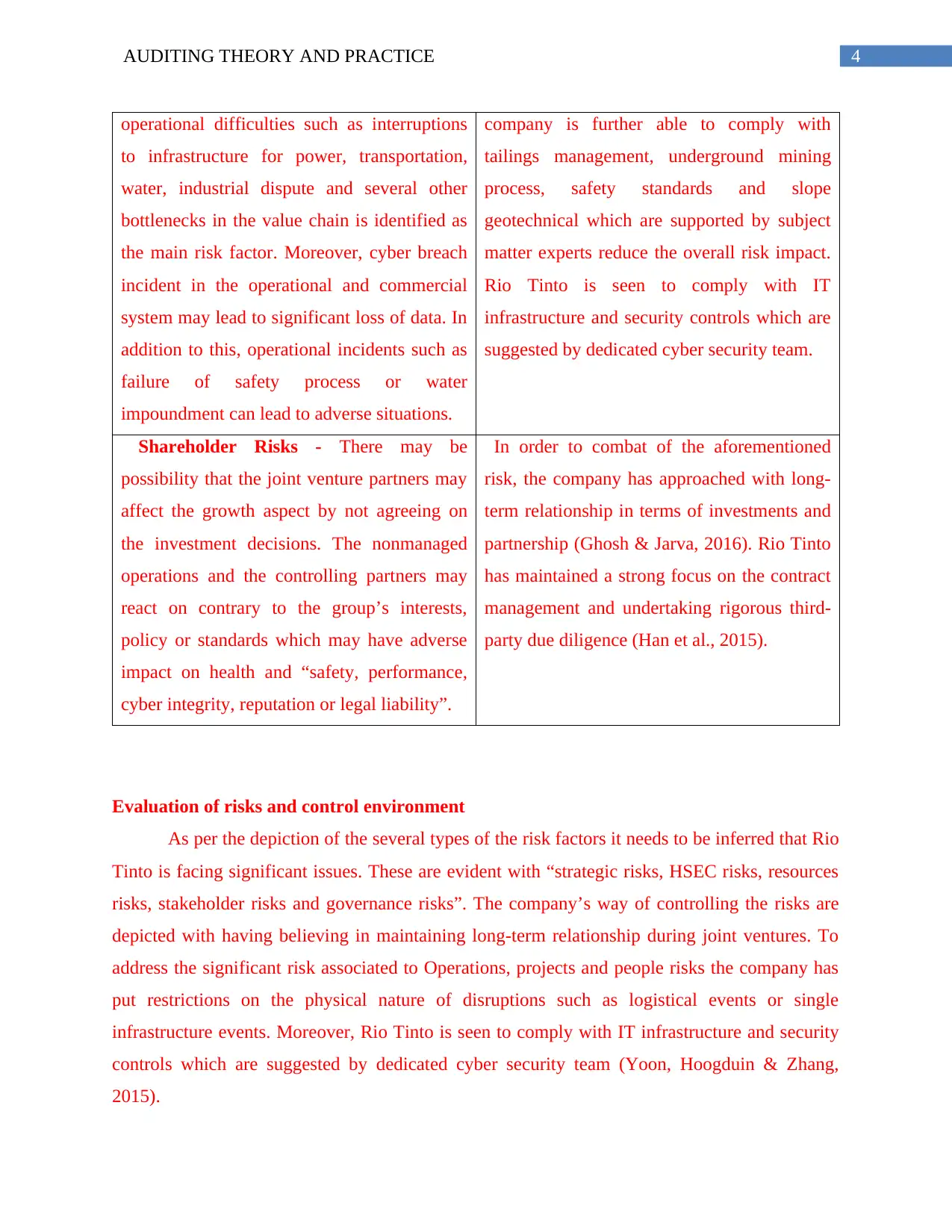
4AUDITING THEORY AND PRACTICE
operational difficulties such as interruptions
to infrastructure for power, transportation,
water, industrial dispute and several other
bottlenecks in the value chain is identified as
the main risk factor. Moreover, cyber breach
incident in the operational and commercial
system may lead to significant loss of data. In
addition to this, operational incidents such as
failure of safety process or water
impoundment can lead to adverse situations.
company is further able to comply with
tailings management, underground mining
process, safety standards and slope
geotechnical which are supported by subject
matter experts reduce the overall risk impact.
Rio Tinto is seen to comply with IT
infrastructure and security controls which are
suggested by dedicated cyber security team.
Shareholder Risks - There may be
possibility that the joint venture partners may
affect the growth aspect by not agreeing on
the investment decisions. The nonmanaged
operations and the controlling partners may
react on contrary to the group’s interests,
policy or standards which may have adverse
impact on health and “safety, performance,
cyber integrity, reputation or legal liability”.
In order to combat of the aforementioned
risk, the company has approached with long-
term relationship in terms of investments and
partnership (Ghosh & Jarva, 2016). Rio Tinto
has maintained a strong focus on the contract
management and undertaking rigorous third-
party due diligence (Han et al., 2015).
Evaluation of risks and control environment
As per the depiction of the several types of the risk factors it needs to be inferred that Rio
Tinto is facing significant issues. These are evident with “strategic risks, HSEC risks, resources
risks, stakeholder risks and governance risks”. The company’s way of controlling the risks are
depicted with having believing in maintaining long-term relationship during joint ventures. To
address the significant risk associated to Operations, projects and people risks the company has
put restrictions on the physical nature of disruptions such as logistical events or single
infrastructure events. Moreover, Rio Tinto is seen to comply with IT infrastructure and security
controls which are suggested by dedicated cyber security team (Yoon, Hoogduin & Zhang,
2015).
operational difficulties such as interruptions
to infrastructure for power, transportation,
water, industrial dispute and several other
bottlenecks in the value chain is identified as
the main risk factor. Moreover, cyber breach
incident in the operational and commercial
system may lead to significant loss of data. In
addition to this, operational incidents such as
failure of safety process or water
impoundment can lead to adverse situations.
company is further able to comply with
tailings management, underground mining
process, safety standards and slope
geotechnical which are supported by subject
matter experts reduce the overall risk impact.
Rio Tinto is seen to comply with IT
infrastructure and security controls which are
suggested by dedicated cyber security team.
Shareholder Risks - There may be
possibility that the joint venture partners may
affect the growth aspect by not agreeing on
the investment decisions. The nonmanaged
operations and the controlling partners may
react on contrary to the group’s interests,
policy or standards which may have adverse
impact on health and “safety, performance,
cyber integrity, reputation or legal liability”.
In order to combat of the aforementioned
risk, the company has approached with long-
term relationship in terms of investments and
partnership (Ghosh & Jarva, 2016). Rio Tinto
has maintained a strong focus on the contract
management and undertaking rigorous third-
party due diligence (Han et al., 2015).
Evaluation of risks and control environment
As per the depiction of the several types of the risk factors it needs to be inferred that Rio
Tinto is facing significant issues. These are evident with “strategic risks, HSEC risks, resources
risks, stakeholder risks and governance risks”. The company’s way of controlling the risks are
depicted with having believing in maintaining long-term relationship during joint ventures. To
address the significant risk associated to Operations, projects and people risks the company has
put restrictions on the physical nature of disruptions such as logistical events or single
infrastructure events. Moreover, Rio Tinto is seen to comply with IT infrastructure and security
controls which are suggested by dedicated cyber security team (Yoon, Hoogduin & Zhang,
2015).
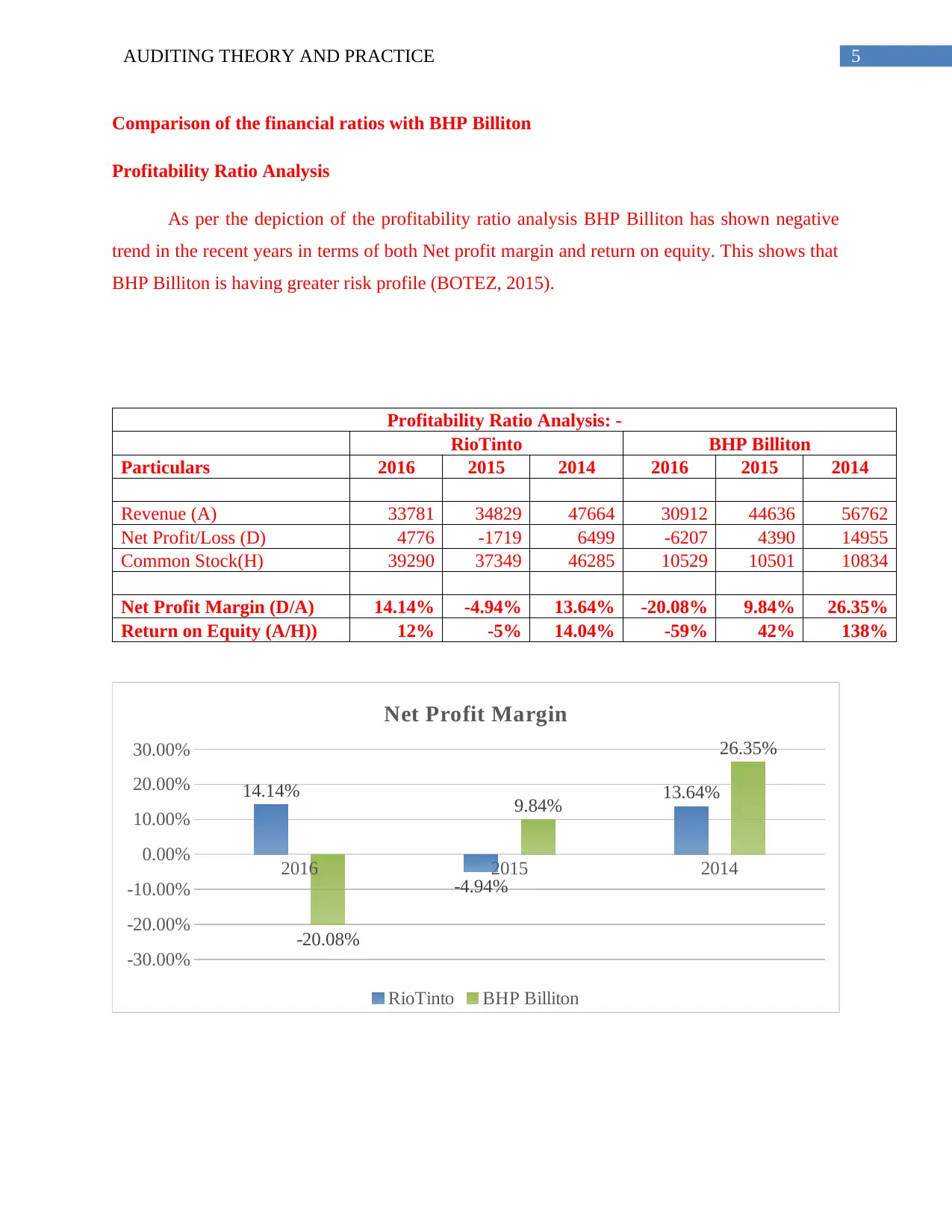
5AUDITING THEORY AND PRACTICE
Comparison of the financial ratios with BHP Billiton
Profitability Ratio Analysis
As per the depiction of the profitability ratio analysis BHP Billiton has shown negative
trend in the recent years in terms of both Net profit margin and return on equity. This shows that
BHP Billiton is having greater risk profile (BOTEZ, 2015).
Profitability Ratio Analysis: -
RioTinto BHP Billiton
Particulars 2016 2015 2014 2016 2015 2014
Revenue (A) 33781 34829 47664 30912 44636 56762
Net Profit/Loss (D) 4776 -1719 6499 -6207 4390 14955
Common Stock(H) 39290 37349 46285 10529 10501 10834
Net Profit Margin (D/A) 14.14% -4.94% 13.64% -20.08% 9.84% 26.35%
Return on Equity (A/H)) 12% -5% 14.04% -59% 42% 138%
2016 2015 2014
-30.00%
-20.00%
-10.00%
0.00%
10.00%
20.00%
30.00%
14.14%
-4.94%
13.64%
-20.08%
9.84%
26.35%
Net Profit Margin
RioTinto BHP Billiton
Comparison of the financial ratios with BHP Billiton
Profitability Ratio Analysis
As per the depiction of the profitability ratio analysis BHP Billiton has shown negative
trend in the recent years in terms of both Net profit margin and return on equity. This shows that
BHP Billiton is having greater risk profile (BOTEZ, 2015).
Profitability Ratio Analysis: -
RioTinto BHP Billiton
Particulars 2016 2015 2014 2016 2015 2014
Revenue (A) 33781 34829 47664 30912 44636 56762
Net Profit/Loss (D) 4776 -1719 6499 -6207 4390 14955
Common Stock(H) 39290 37349 46285 10529 10501 10834
Net Profit Margin (D/A) 14.14% -4.94% 13.64% -20.08% 9.84% 26.35%
Return on Equity (A/H)) 12% -5% 14.04% -59% 42% 138%
2016 2015 2014
-30.00%
-20.00%
-10.00%
0.00%
10.00%
20.00%
30.00%
14.14%
-4.94%
13.64%
-20.08%
9.84%
26.35%
Net Profit Margin
RioTinto BHP Billiton
⊘ This is a preview!⊘
Do you want full access?
Subscribe today to unlock all pages.

Trusted by 1+ million students worldwide
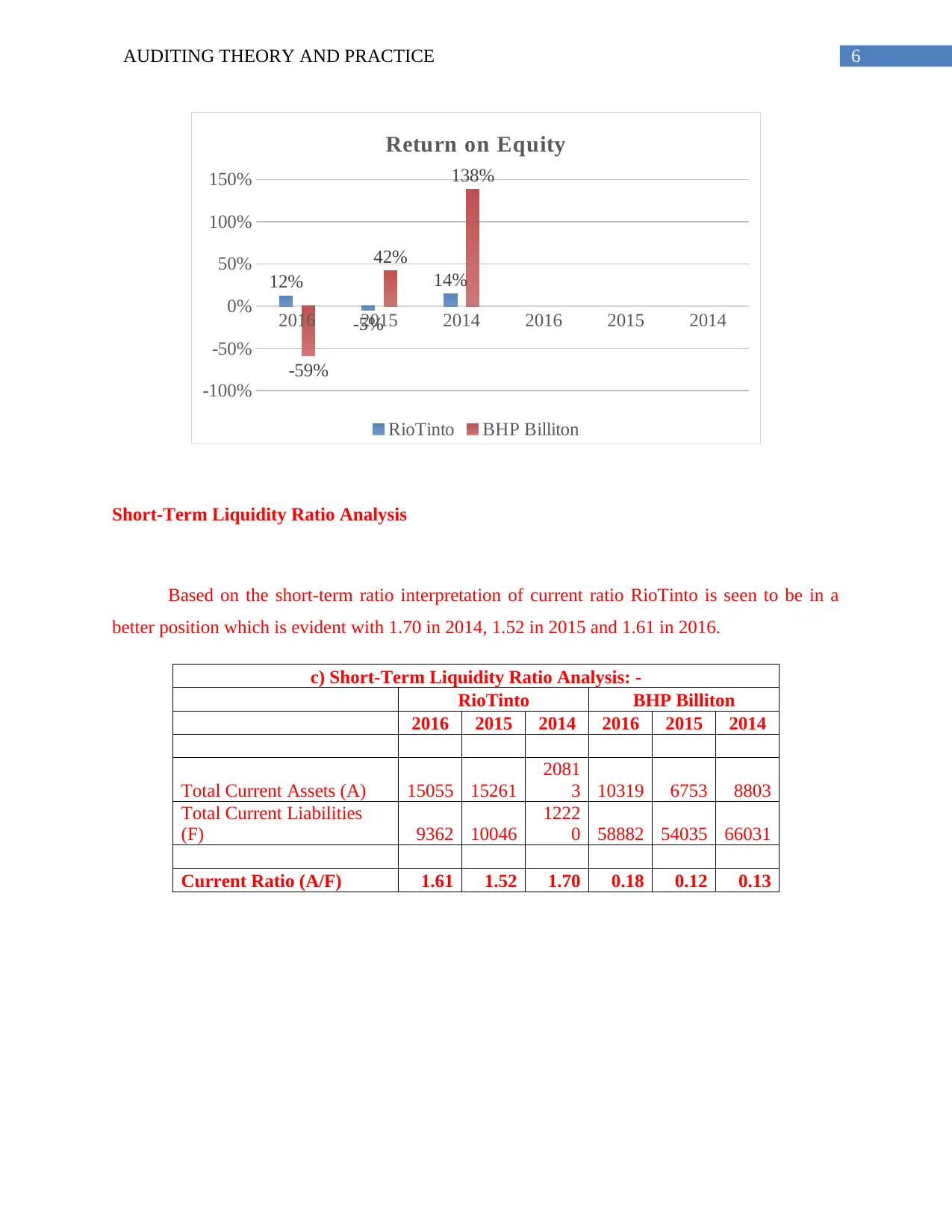
6AUDITING THEORY AND PRACTICE
2016 2015 2014 2016 2015 2014
-100%
-50%
0%
50%
100%
150%
12%
-5%
14%
-59%
42%
138%
Return on Equity
RioTinto BHP Billiton
Short-Term Liquidity Ratio Analysis
Based on the short-term ratio interpretation of current ratio RioTinto is seen to be in a
better position which is evident with 1.70 in 2014, 1.52 in 2015 and 1.61 in 2016.
c) Short-Term Liquidity Ratio Analysis: -
RioTinto BHP Billiton
2016 2015 2014 2016 2015 2014
Total Current Assets (A) 15055 15261
2081
3 10319 6753 8803
Total Current Liabilities
(F) 9362 10046
1222
0 58882 54035 66031
Current Ratio (A/F) 1.61 1.52 1.70 0.18 0.12 0.13
2016 2015 2014 2016 2015 2014
-100%
-50%
0%
50%
100%
150%
12%
-5%
14%
-59%
42%
138%
Return on Equity
RioTinto BHP Billiton
Short-Term Liquidity Ratio Analysis
Based on the short-term ratio interpretation of current ratio RioTinto is seen to be in a
better position which is evident with 1.70 in 2014, 1.52 in 2015 and 1.61 in 2016.
c) Short-Term Liquidity Ratio Analysis: -
RioTinto BHP Billiton
2016 2015 2014 2016 2015 2014
Total Current Assets (A) 15055 15261
2081
3 10319 6753 8803
Total Current Liabilities
(F) 9362 10046
1222
0 58882 54035 66031
Current Ratio (A/F) 1.61 1.52 1.70 0.18 0.12 0.13
Paraphrase This Document
Need a fresh take? Get an instant paraphrase of this document with our AI Paraphraser
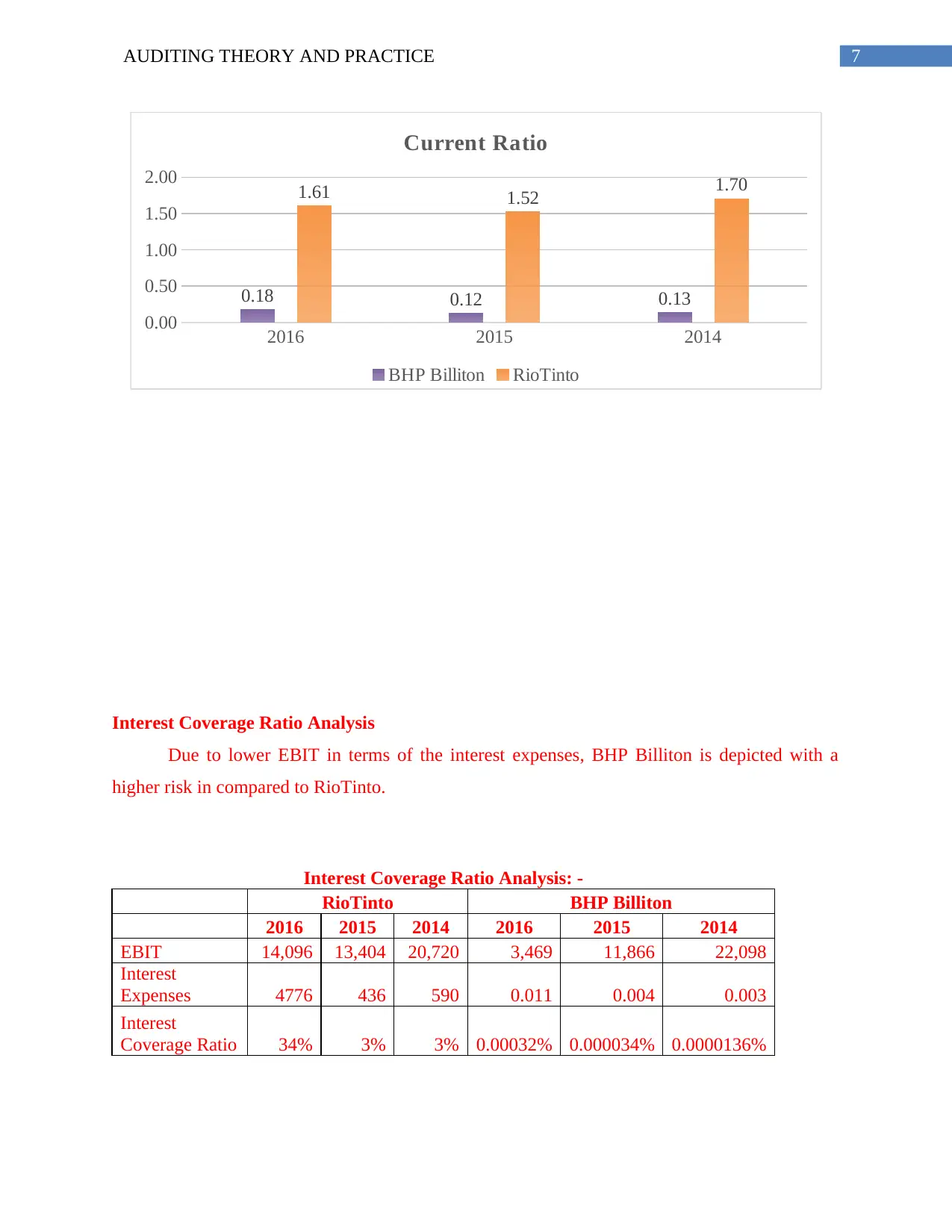
7AUDITING THEORY AND PRACTICE
2016 2015 2014
0.00
0.50
1.00
1.50
2.00
0.18 0.12 0.13
1.61 1.52 1.70
Current Ratio
BHP Billiton RioTinto
Interest Coverage Ratio Analysis
Due to lower EBIT in terms of the interest expenses, BHP Billiton is depicted with a
higher risk in compared to RioTinto.
Interest Coverage Ratio Analysis: -
RioTinto BHP Billiton
2016 2015 2014 2016 2015 2014
EBIT 14,096 13,404 20,720 3,469 11,866 22,098
Interest
Expenses 4776 436 590 0.011 0.004 0.003
Interest
Coverage Ratio 34% 3% 3% 0.00032% 0.000034% 0.0000136%
2016 2015 2014
0.00
0.50
1.00
1.50
2.00
0.18 0.12 0.13
1.61 1.52 1.70
Current Ratio
BHP Billiton RioTinto
Interest Coverage Ratio Analysis
Due to lower EBIT in terms of the interest expenses, BHP Billiton is depicted with a
higher risk in compared to RioTinto.
Interest Coverage Ratio Analysis: -
RioTinto BHP Billiton
2016 2015 2014 2016 2015 2014
EBIT 14,096 13,404 20,720 3,469 11,866 22,098
Interest
Expenses 4776 436 590 0.011 0.004 0.003
Interest
Coverage Ratio 34% 3% 3% 0.00032% 0.000034% 0.0000136%
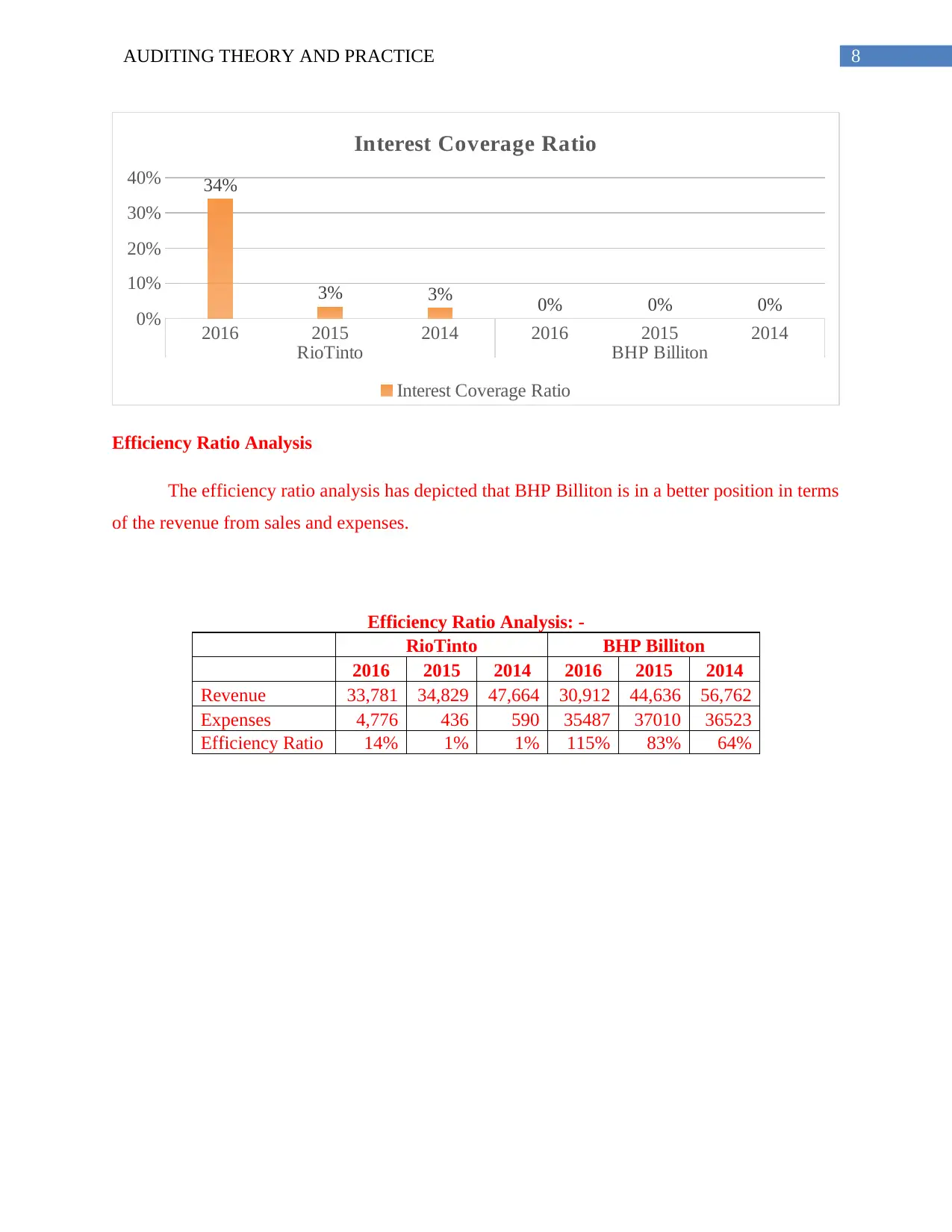
8AUDITING THEORY AND PRACTICE
2016 2015 2014 2016 2015 2014
RioTinto BHP Billiton
0%
10%
20%
30%
40% 34%
3% 3% 0% 0% 0%
Interest Coverage Ratio
Interest Coverage Ratio
Efficiency Ratio Analysis
The efficiency ratio analysis has depicted that BHP Billiton is in a better position in terms
of the revenue from sales and expenses.
Efficiency Ratio Analysis: -
RioTinto BHP Billiton
2016 2015 2014 2016 2015 2014
Revenue 33,781 34,829 47,664 30,912 44,636 56,762
Expenses 4,776 436 590 35487 37010 36523
Efficiency Ratio 14% 1% 1% 115% 83% 64%
2016 2015 2014 2016 2015 2014
RioTinto BHP Billiton
0%
10%
20%
30%
40% 34%
3% 3% 0% 0% 0%
Interest Coverage Ratio
Interest Coverage Ratio
Efficiency Ratio Analysis
The efficiency ratio analysis has depicted that BHP Billiton is in a better position in terms
of the revenue from sales and expenses.
Efficiency Ratio Analysis: -
RioTinto BHP Billiton
2016 2015 2014 2016 2015 2014
Revenue 33,781 34,829 47,664 30,912 44,636 56,762
Expenses 4,776 436 590 35487 37010 36523
Efficiency Ratio 14% 1% 1% 115% 83% 64%
⊘ This is a preview!⊘
Do you want full access?
Subscribe today to unlock all pages.

Trusted by 1+ million students worldwide

9AUDITING THEORY AND PRACTICE
2016 2015 2014 2016 2015 2014
RioTinto BHP Billiton
0%
20%
40%
60%
80%
100%
120%
140%
14% 1% 1%
115%
83%
64%
Efficiency Ratio
Efficiency Ratio
Market Performance Analysis
The market performance ratio analysis has depicted that despite of reducing trend of EPS
in both the companies, RioTinto has a better EPS in compared to BHP Billiton.
Earnings per share Analysis: -
RioTinto BHP Billiton
2016 2015 2014 2016 2015 2014
Basic
EPS 284 249 503 -148 -57 117
2016 2015 2014 2016 2015 2014
RioTinto BHP Billiton
0%
20%
40%
60%
80%
100%
120%
140%
14% 1% 1%
115%
83%
64%
Efficiency Ratio
Efficiency Ratio
Market Performance Analysis
The market performance ratio analysis has depicted that despite of reducing trend of EPS
in both the companies, RioTinto has a better EPS in compared to BHP Billiton.
Earnings per share Analysis: -
RioTinto BHP Billiton
2016 2015 2014 2016 2015 2014
Basic
EPS 284 249 503 -148 -57 117
Paraphrase This Document
Need a fresh take? Get an instant paraphrase of this document with our AI Paraphraser
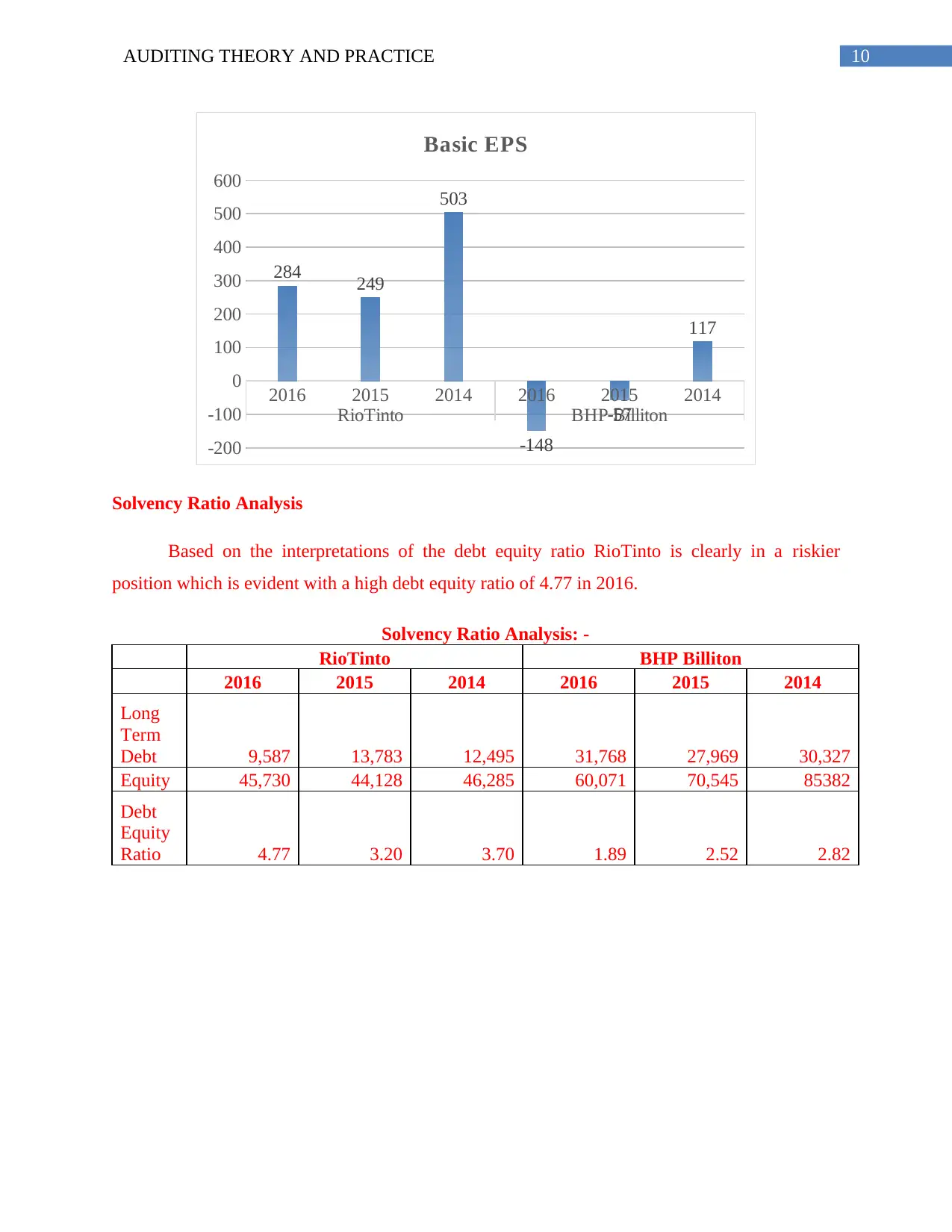
10AUDITING THEORY AND PRACTICE
2016 2015 2014 2016 2015 2014
RioTinto BHP Billiton
-200
-100
0
100
200
300
400
500
600
284 249
503
-148
-57
117
Basic EPS
Solvency Ratio Analysis
Based on the interpretations of the debt equity ratio RioTinto is clearly in a riskier
position which is evident with a high debt equity ratio of 4.77 in 2016.
Solvency Ratio Analysis: -
RioTinto BHP Billiton
2016 2015 2014 2016 2015 2014
Long
Term
Debt 9,587 13,783 12,495 31,768 27,969 30,327
Equity 45,730 44,128 46,285 60,071 70,545 85382
Debt
Equity
Ratio 4.77 3.20 3.70 1.89 2.52 2.82
2016 2015 2014 2016 2015 2014
RioTinto BHP Billiton
-200
-100
0
100
200
300
400
500
600
284 249
503
-148
-57
117
Basic EPS
Solvency Ratio Analysis
Based on the interpretations of the debt equity ratio RioTinto is clearly in a riskier
position which is evident with a high debt equity ratio of 4.77 in 2016.
Solvency Ratio Analysis: -
RioTinto BHP Billiton
2016 2015 2014 2016 2015 2014
Long
Term
Debt 9,587 13,783 12,495 31,768 27,969 30,327
Equity 45,730 44,128 46,285 60,071 70,545 85382
Debt
Equity
Ratio 4.77 3.20 3.70 1.89 2.52 2.82
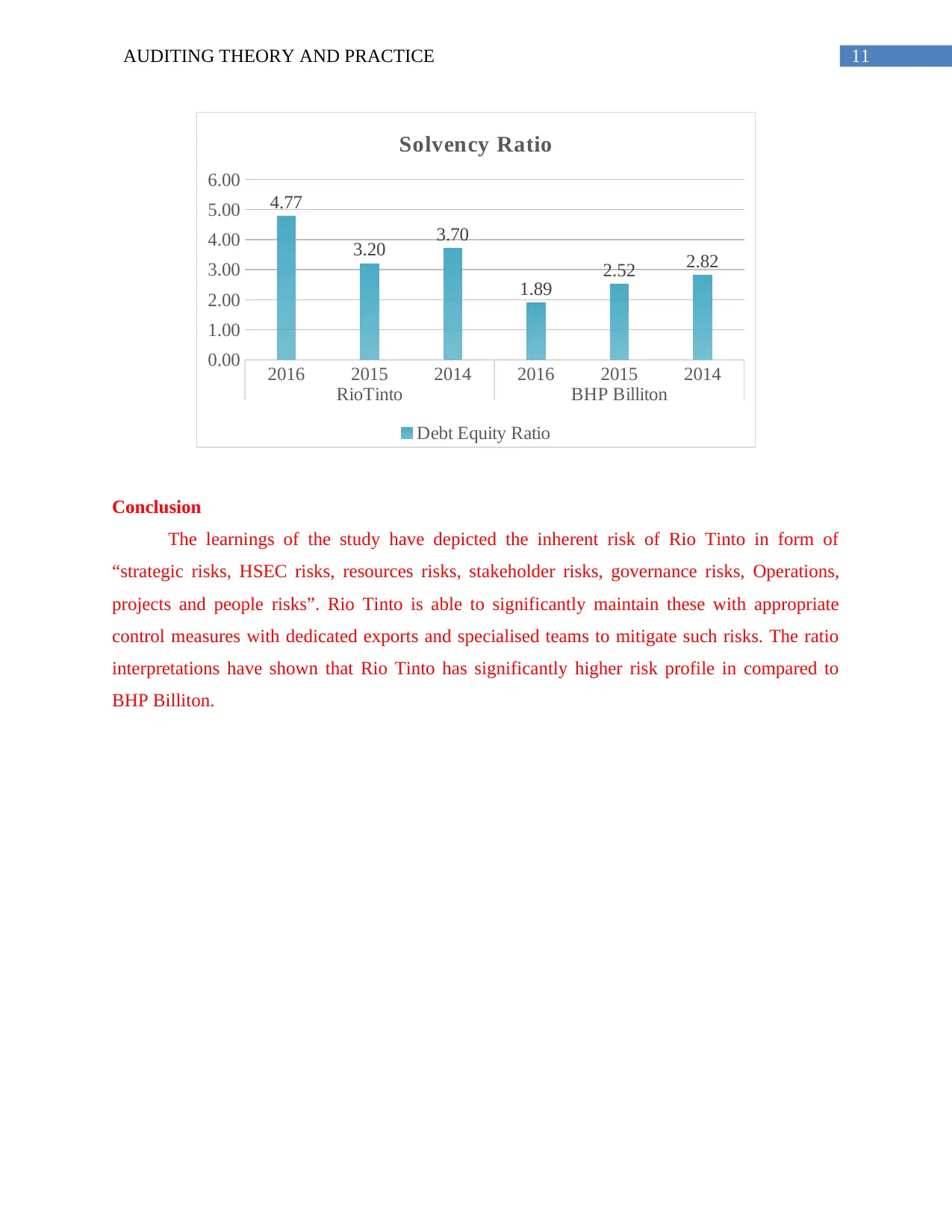
11AUDITING THEORY AND PRACTICE
2016 2015 2014 2016 2015 2014
RioTinto BHP Billiton
0.00
1.00
2.00
3.00
4.00
5.00
6.00
4.77
3.20 3.70
1.89
2.52 2.82
Solvency Ratio
Debt Equity Ratio
Conclusion
The learnings of the study have depicted the inherent risk of Rio Tinto in form of
“strategic risks, HSEC risks, resources risks, stakeholder risks, governance risks, Operations,
projects and people risks”. Rio Tinto is able to significantly maintain these with appropriate
control measures with dedicated exports and specialised teams to mitigate such risks. The ratio
interpretations have shown that Rio Tinto has significantly higher risk profile in compared to
BHP Billiton.
2016 2015 2014 2016 2015 2014
RioTinto BHP Billiton
0.00
1.00
2.00
3.00
4.00
5.00
6.00
4.77
3.20 3.70
1.89
2.52 2.82
Solvency Ratio
Debt Equity Ratio
Conclusion
The learnings of the study have depicted the inherent risk of Rio Tinto in form of
“strategic risks, HSEC risks, resources risks, stakeholder risks, governance risks, Operations,
projects and people risks”. Rio Tinto is able to significantly maintain these with appropriate
control measures with dedicated exports and specialised teams to mitigate such risks. The ratio
interpretations have shown that Rio Tinto has significantly higher risk profile in compared to
BHP Billiton.
⊘ This is a preview!⊘
Do you want full access?
Subscribe today to unlock all pages.

Trusted by 1+ million students worldwide
1 out of 13